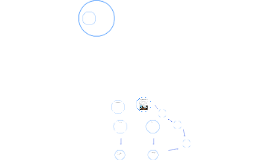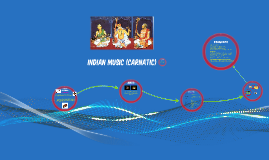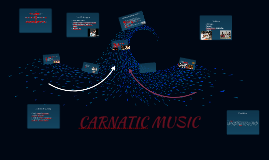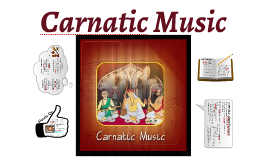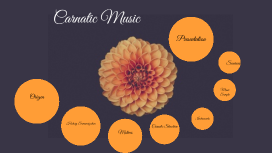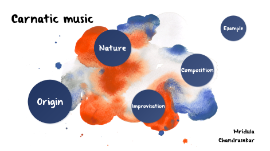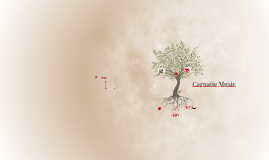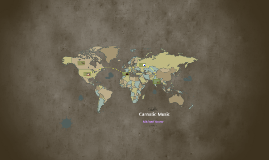Carnatic music
Transcript: Mridula Chandrasekar Carnatic music Origin Origin 1. Carnatic music or Karnāṭak music or Karnāṭaka Saṃgīta is a style of music found in the south of India. 2. It includes the states of Tamil Nadu, Kerala, Karnataka, Andra Pradesh and Telengana. Indian classical music is believed to be a divine art form which originated from the Devas and Devis (Hindu Gods and Goddesses) and is venerated as symbolic of nāda brāhman (transcendental sound or sound vibration). Ancient treatises also describe the connection of the origin of the swaras, or notes, to the sounds of animals and birds and man's effort to simulate these sounds through a keen sense of observation and perception. Carnatic music was mainly patronized by the local kings of the Kingdom of Mysore, Kingdom of Travancore, and the Maratha rulers of Tanjore in the 18th through 20th centuries. History - History The Sama Veda, which is believed to have laid the foundation for Indian classical music, consists of hymns from the Rigveda, set to musical tunes which would be sung using three to seven musical notes during Vedic yajnas. The Yajur-Veda, which mainly consists of sacrificial formulae, mentions the veena as an accompaniment to vocal recitations. Music and the Vedas music and the vedas References to Indian classical music are made in many ancient texts, including epics like the Ramayana and Mahabharata. The Yajnavalkya Smriti mentions "The one who is well versed in veena, one who has the knowledge of srutis and one who is adept in tala, attains liberation (moksha) without doubt"). Carnatic music is based as it is today on musical concepts (including swara, raga, and tala) that were described in detail in several ancient works, particularly the Bharata's Natya Shastra and Silappadhikaram by Ilango Adigal. Music and Epic Tales music and epic tales Nature Nature The main emphasis in Carnatic music is on vocal music; most compositions are written to be sung, and even when played on instruments, they are meant to be performed in a singing style (known as gāyaki). Carnatic music rests on two main elements: rāga, the modes or melodic formulæ, and tāḷa, the rhythmic cycles Elements Elements The important elements of carnatic music are- 1. Śruti 2. Swara 3. Raga system 4. Tala system Śruti commonly refers to musical pitch. It is the approximate equivalent of a tonic (or less precisely a key) in Western music; it is the note from which all the others are derived. It is also used in the sense of graded pitches in an octave. While there are an infinite number of sounds falling within a scale (or raga) in Carnatic music, the number that can be distinguished by auditory perception is twenty-two (although over the years, several of them have converged). In this sense, while sruti is determined by auditory perception, it is also an expression in the listener's mind. Sruti Sruti Swara refers to a type of musical sound that is a single note, which defines a relative (higher or lower) position of a note, rather than a defined frequency. Swaras also refer to the solfege of Carnatic music, which consist of seven notes, "sa-ri-ga-ma-pa-da-ni" (compare with the Hindustani sargam: sa-re-ga-ma-pa-dha-ni or Western do-re-mi-fa-so-la-ti). These names are abbreviations of the longer names shadja, rishabha, gandhara, madhyama, panchama, dhaivata and nishada. Unlike other music systems, every member of the solfege (called a swara) has three variants. The exceptions are the drone notes, shadja and panchama (also known as the tonic and the dominant), which have only one form; and madhyama (the subdominant), which has two forms. A 7th century stone inscription in Kudumiyan Malai Swara Swara A raga in Carnatic music prescribes a set of rules for building a melody – very similar to the Western concept of mode. It specifies rules for movements up (aarohanam) and down (avarohanam), the scale of which notes should figure more and which notes should be used more sparingly, which notes may be sung with gamaka (ornamentation), which phrases should be used or avoided, and so on. In effect, it is a series of obligatory musical events which must be observed, either absolutely or with a particular frequency Raga System Raga System In Carnatic music, the sampoorna ragas (those with all seven notes in their scales) are classified into a system called the melakarta, which groups them according to the kinds of notes that they have. There are seventy-two melakarta ragas, thirty six of whose madhyama (subdominant) is shuddha (perfect fourth from the tonic), the remaining thirty-six of whose madhyama (subdominant) is prati (an augmented fourth from the tonic). The ragas are grouped into sets of six, called chakras ("wheels", though actually segments in the conventional representation) grouped according to the supertonic and mediant scale degrees. There is a system known as the katapayadi sankhya to determine the names of melakarta ragas. Melakarta Melakarta system Tala refers to a fixed time cycle or metre, set






